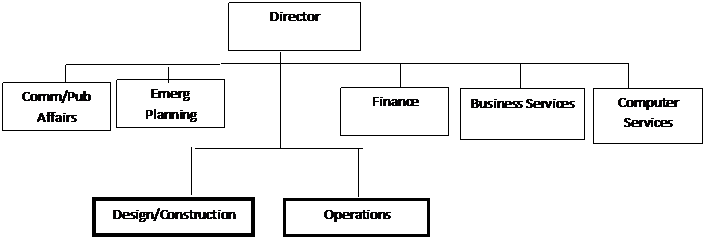
Module 3
This module and Chapter 3 of Meredith continues to expand your "feel" for projects via a discussion of problems encountered by a project manager and the attributes of project manager the might help overcome these problems. Before you read it, let me explain a little about the difference between a "functional" and a "projectized" organization. Here's a San Francisco Department page:
http://www.sfdpw.org/index.aspx?page=1088
You'll note under the DIRECTOR, each with a deputy or interim assistant-type director and the principal task of that area. There are really two primary functions in this department, plus five staff functions.
This is a functional organization, and the table of organization could be made to look like this. (It was scrunched together to fit on one web page.)

.
The five areas in the second line are on the staff of the Director. Most manufacturing and industrial operations are organized as functional organizations and follow the pattern above. Meredith spends a lot of time describing the results of this organization of the parent and how it affects projects. He'll spend more time on this in Chapter 5, but for now, consider a new sewer pipe to be built next winter. Who will manage the project? The Design/Construction Division? Probably. What happens if these are all busy or understaffed already.
Suppose the Director borrows a project manager-type from Operations to build the sewer. Then that manger tries to form a team. Do you suppose the Operations will offer their best people?
Most engineering and construction organizations are organized as "projectized" or "matrix" organizations, these have a different set of problems.
Section 3.4 deals with cultural differences, of which a modern manager needs to be aware.